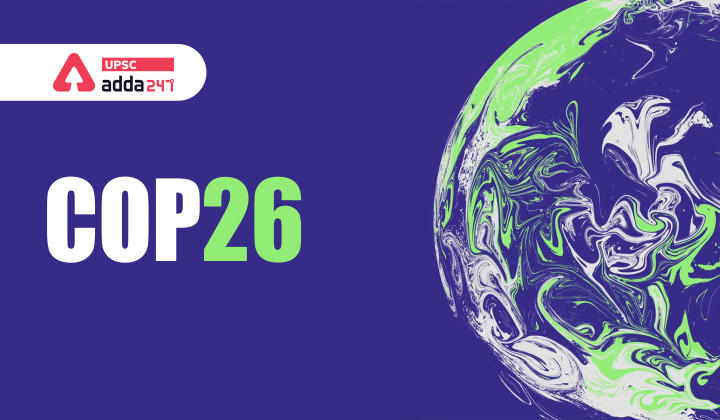Introduction
The COP 26 UN Climate Change Conference, hosted by the UK in partnership with Italy, will take place from 31 October to 12 November 2021 in the Scottish Event Campus (SEC) in Glasgow, UK.
The COP 26 summit will bring parties together to accelerate action towards the goals of the Paris Agreement and the UN Framework Convention on Climate Change.
What is COP 26?
- COP 26 is the 2021 edition of the United Nations annual climate change conference
- COP stands for Conference of the Parties. Parties are the signatories of the United Nations Framework Convention on Climate Change (UNFCCC) – a treaty agreed in 1994 which has 197 Parties (196 countries and the EU).
- The 2021 conference, hosted by the UK, together with their partners Italy, in Glasgow, will be the 26th meeting of the Parties, which is why it’s called COP26.
- United Nations climate change conferences are among the largest international meetings in the world. The negotiations between governments are complex and involve officials from every country in the world as well as representatives from civil society and the global news media.
What happens at a COP?
- Activity at a COP takes place in two different zones – the Blue Zone and the Green Zone.
- The Blue Zone is for people registered with the UN body tasked with coordinating the global response to the threat of climate change – the United Nations Framework Convention on Climate Change (UNFCCC). In the Blue Zone, you might be part of a national delegation, work for the United Nations and related organisations & agencies or be a member of the media or non-profit observer organisation. In the Blue Zone, delegates from countries meet for both formal negotiations and informal consultations. They may also take part in meetings with other delegations to clarify their position and interests with the aim of reaching an agreement or overcoming a negotiating deadlock. The UNFCCC will also host a range of events, including technical briefings, to support the negotiations process.
- The Green Zone is for the general public. There will be a wide range of events, including workshops, art exhibitions and installations, as well as presentations, demonstrations of technology and musical performances for everyone to attend.
What is the Paris Agreement?
- The Paris Agreement was agreed upon at COP21 in 2015.
- For the first time ever it saw almost every country around the world enter into a legally binding commitment to reduce emissions. It was ‘top down’ in that every country – no matter how big or small – signed up to cutting carbon emissions to limit global warming to well below 2 degrees and ideally to 1.5 degrees above pre-industrial levels, and it was ‘bottom up’ in that it left room for each individual country to decide how they would get there. These were called Nationally Determined Contributions (NDCs).
- The Paris Agreement also set out ambitious goals on adaptation and on finance, recognising that many people around the world are already experiencing the impacts of a changing climate and that support – financial, technical and capacity building – would be needed.
India’s Focus at COP 26?
India is working seriously to reduce its emissions intensity by 33 – 35% between 2005 and 2030(as per the INDCs). So, India will focus on Predictable Carbon Finance, as we are perhaps the only G20 country to have fulfilled our NDCs and outperformed them. In the last six years, we have increased our renewable energy capacity by two and half times and solar energy has increased 13 times. We have also announced a hydrogen energy mission that will generate energy from green sources.
What is climate finance?
- Climate finance refers to local, national or transnational financing—drawn from public, private and alternative sources of financing—that seeks to support mitigation and adaptation actions that will address climate change.
- The Convention, the Kyoto Protocol and the Paris Agreement calls for financial assistance from Parties with more financial resources to those that are less endowed and more vulnerable.
What is Article 6 of the Paris Agreement?
It recognizes that some Parties choose to pursue voluntary cooperation in the implementation of their nationally determined contributions to allow for higher ambition in their mitigation and adaptation actions and to promote sustainable development and environmental integrity.
Why does limiting temperature rise to 1.5 degrees matter?
- At 2 degrees of global warming, there would be widespread and severe impacts on people and nature. A third of the world’s population would be regularly exposed to severe heat, leading to health problems and more heat-related deaths.
- Almost all warm-water coral reefs would be destroyed, and the Arctic sea ice would melt entirely at least one summer per decade, with devastating impacts on the wildlife and communities they support.
- We cannot rule out the possibility that irreversible loss of ice sheets in Greenland and the Antarctic could be triggered, leading to several metres of sea-level rise over centuries to come.
- At 1.5°C, the impacts would be serious, but less severe. There would be lower risks of food and water shortages, lower risks to economic growth and fewer species at risk of extinction. Threats to human health from air pollution, disease, malnutrition and exposure to extreme heat would also be lower. That is why every fraction of a degree of warming matters.



 TSPSC Group 1 Question Paper 2024, Downl...
TSPSC Group 1 Question Paper 2024, Downl...
 TSPSC Group 1 Answer key 2024 Out, Downl...
TSPSC Group 1 Answer key 2024 Out, Downl...
 UPSC Prelims 2024 Question Paper, Downlo...
UPSC Prelims 2024 Question Paper, Downlo...




